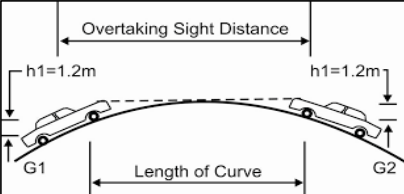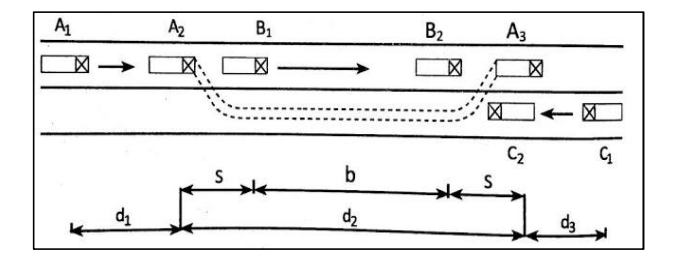
Over Taking Requirement and Factors governing the distance:
Theoretically, there shouldn’t need to be any overtaking if every vehicle travels down a road at the intended pace. Each driver is free to travel at lesser speeds, therefore all vehicles actually don’t move at the planned speed. This is especially true when there is mixed traffic. Fast moving traffic must be passed or overtaken in order to proceed. The Minimum Overtaking Sight Distance (OSD) or Safe Passing Sight Distance is the shortest distance that the driver of a vehicle must see in order to safely pass a slow-moving vehicle in front of them.
The OSD is the distance measured along the centre line of the road which a driver with his eye level at 1.2m above the road surface can see the top of an object 1.2m above the road surface.
Factors Affecting OSD:
- The velocities of the vehicles being passed, being passed, and the vehicles coming from the opposite direction
- The distance between vehicles that are being passed and those that are being overtaken; the minimum distance depends on the speeds Road gradient, overtaking vehicle’s rate of acceleration, and the driver’s skill and reaction time.
Analysis of OSD on a Two – Way Road:
Simple overtaking process on a 2 – lane highway with 2 – way traffic movement
Vehicle A wants to pass another slow-moving vehicle B going at a speed of vb m/sec or Vb kmph while travelling at its design speed of v m/sec or V kmph. Before oncoming vehicle C approaches the overtaking stretch, vehicle A must speed, change to the adjacent right-side lane, complete the overtaking manoeuvre, and then return to the left lane.
The overtaking manoeuvre may be split up into 3 operations, thus dividing OSD into 3 parts d1, d2and d3.
- d1 is the distance (m) travelled by the overtaking vehicle A during the reaction time, t (secs) of the driver from position A1 to A2 before starting to overtake the slow vehicle B
- d2 is the distance travelled (m) travelled by the vehicle A during the actual overtaking operation during T (secs) from position A2 to A3
- d3 is the distance (m) travelled by oncoming vehicle C during the actual overtaking operation of A during T (secs) from position C1 to C2. Thus, on a 2-lane road with 2-way traffic the OSD = d1 + d2 + d3 in meters

